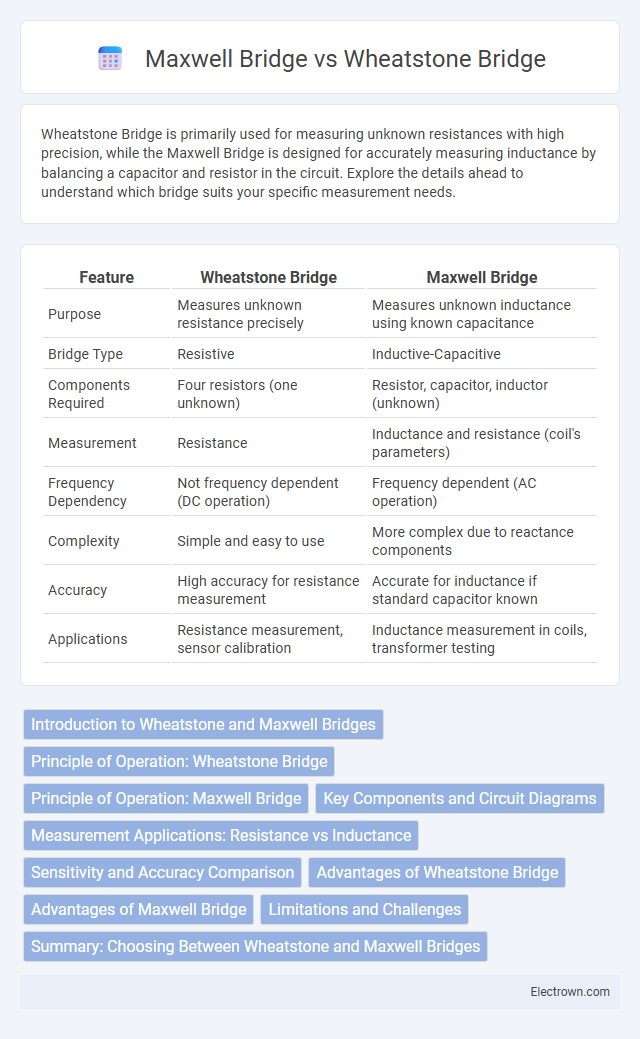Wheatstone Bridge is primarily used for measuring unknown resistances with high precision, while the Maxwell Bridge is designed for accurately measuring inductance by balancing a capacitor and resistor in the circuit. Explore the details ahead to understand which bridge suits your specific measurement needs.
Table of Comparison
| Feature | Wheatstone Bridge | Maxwell Bridge |
|---|---|---|
| Purpose | Measures unknown resistance precisely | Measures unknown inductance using known capacitance |
| Bridge Type | Resistive | Inductive-Capacitive |
| Components Required | Four resistors (one unknown) | Resistor, capacitor, inductor (unknown) |
| Measurement | Resistance | Inductance and resistance (coil's parameters) |
| Frequency Dependency | Not frequency dependent (DC operation) | Frequency dependent (AC operation) |
| Complexity | Simple and easy to use | More complex due to reactance components |
| Accuracy | High accuracy for resistance measurement | Accurate for inductance if standard capacitor known |
| Applications | Resistance measurement, sensor calibration | Inductance measurement in coils, transformer testing |
Introduction to Wheatstone and Maxwell Bridges
Wheatstone Bridge is a fundamental electrical circuit used to precisely measure unknown resistances by balancing two legs of a bridge circuit, ensuring accurate and reliable results in various applications. Maxwell Bridge is specifically designed for measuring inductance by comparing an unknown inductor to known capacitance and resistance, making it ideal for testing inductors and coils in AC circuits. Understanding these bridges helps you select the appropriate method for accurate electrical component measurement and calibration.
Principle of Operation: Wheatstone Bridge
The Wheatstone Bridge operates on the principle of null deflection, balancing four resistors in a diamond-shaped configuration to precisely measure an unknown resistance. When the ratio of two known resistors equals the ratio of the unknown resistor and the adjustable resistor, the galvanometer connected between the bridge's two midpoints shows zero current, indicating equilibrium. This balance condition allows accurate resistance determination by comparison, making the Wheatstone Bridge fundamental in electrical measurement and sensor calibration.
Principle of Operation: Maxwell Bridge
The Maxwell Bridge operates on the principle of balancing inductive and capacitive reactances in AC circuits to measure unknown inductance by comparing it against known capacitance and resistance. It utilizes a configuration of resistors, a standard capacitor, and an unknown inductor, achieving balance when the voltage between two midpoints is zero, indicating equal impedance ratios. This method offers high accuracy in determining self-inductance by eliminating the effect of coil resistance through precise bridge balancing.
Key Components and Circuit Diagrams
The Wheatstone Bridge consists of four resistors arranged in a diamond shape with a galvanometer connecting two opposite nodes, enabling precise measurement of unknown resistances by balancing the circuit. The Maxwell Bridge replaces two of these resistors with an unknown inductance and a known standard capacitance, allowing it to measure inductance accurately by adjusting the resistors and capacitor until the galvanometer shows zero deflection. Your understanding of the key components and circuit diagrams in these bridges is essential for selecting the appropriate method in impedance measurement tasks.
Measurement Applications: Resistance vs Inductance
Wheatstone Bridge is primarily used for precise measurement of unknown electrical resistances, leveraging the principle of null deflection to ensure accuracy. Maxwell Bridge specializes in measuring inductance by balancing the bridge with known capacitance and resistance values, making it ideal for inductive component testing. Both bridges offer critical solutions in electrical engineering, but Wheatstone Bridge excels in resistance measurement while Maxwell Bridge is optimized for inductance determination.
Sensitivity and Accuracy Comparison
Wheatstone Bridge offers high sensitivity for measuring low resistance values with minimal error, making it ideal for precision resistive measurements. Maxwell Bridge excels in accurately determining inductance by compensating for coil resistance and stray capacitance, providing better accuracy in inductive component analysis. Sensitivity in Wheatstone Bridge depends heavily on the galvanometer, while Maxwell Bridge achieves greater measurement stability through its balanced inductive elements.
Advantages of Wheatstone Bridge
The Wheatstone Bridge offers high accuracy and simplicity in measuring unknown electrical resistances, making it ideal for precise laboratory applications. It requires fewer components than the Maxwell Bridge, reducing complexity and enhancing reliability in practical use. Your measurements benefit from its quick setup and robust performance in detecting small resistance changes.
Advantages of Maxwell Bridge
Maxwell Bridge offers superior accuracy for measuring unknown inductances compared to Wheatstone Bridge, especially at higher frequencies. Its design minimizes the effects of stray capacitance and resistance, providing more reliable results in complex circuit analysis. You benefit from enhanced precision and simplicity when balancing Maxwell Bridge for inductance measurements in electrical engineering applications.
Limitations and Challenges
Wheatstone Bridge faces limitations in measuring very low or very high resistances accurately due to sensitivity and temperature drift, making it less effective for precise industrial applications. Maxwell Bridge struggles with frequency dependency and requires a known standard capacitor, limiting its use for measuring inductance in varying operational conditions. Your choice depends on the specific measurement range and environmental stability needed for accurate impedance analysis.
Summary: Choosing Between Wheatstone and Maxwell Bridges
The Wheatstone bridge provides precise measurement of unknown resistances by balancing two legs of a circuit, making it ideal for simple resistive components. The Maxwell bridge is designed specifically to measure inductance by comparing an unknown inductor with known resistors and capacitors, offering greater accuracy in inductive reactance determination. Selecting between the two depends on whether resistance or inductance measurement is required, with Wheatstone suited for resistive circuits and Maxwell preferred for inductive components.
Wheatstone Bridge vs Maxwell Bridge Infographic

 electrown.com
electrown.com